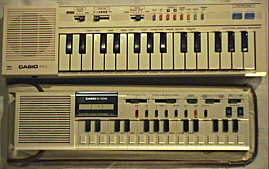 Here you see the Casio PT-1 and below it my original VL-Tone
1 from 1981.
Here you see the Casio PT-1 and below it my original VL-Tone
1 from 1981. |
|
 Here you see the Casio PT-1 and below it my original VL-Tone
1 from 1981.
Here you see the Casio PT-1 and below it my original VL-Tone
1 from 1981. |
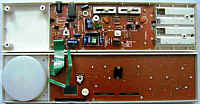 |
 |
 This panel PCB photo can help to find matrix eastereggs in other keyboards
of this hardware class.
This panel PCB photo can help to find matrix eastereggs in other keyboards
of this hardware class. |
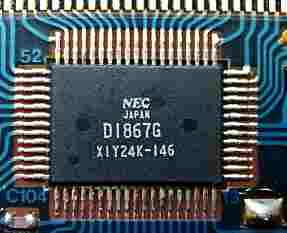 |
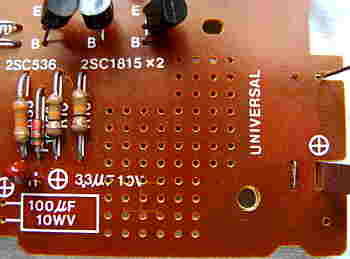 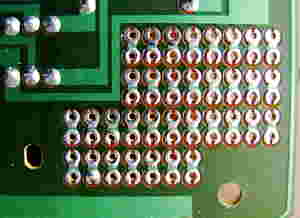 There is a grid of empty test solder holes on the analogue PCB.
There is a grid of empty test solder holes on the analogue PCB. |
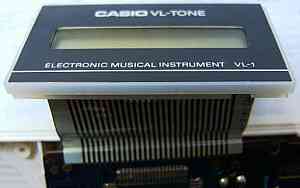 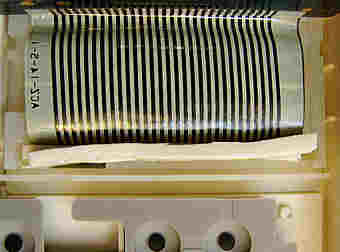 The glued LCD foil cable prone to tear loose. I patched mine with a foam
rubber strip.
The glued LCD foil cable prone to tear loose. I patched mine with a foam
rubber strip. |
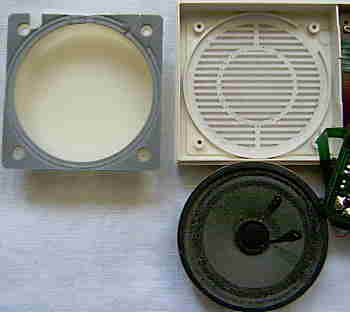 |
caution: Long times ago I forgot my Casio VL-1 in a wardrobe for about a year with batteries inserted. Likely from that time on the LCD became faint and never recovered. I am not sure if corrosive vapours from the slightly leaking batteries damaged it somehow, or if inserted batteries always (or only by a crash when empty?) drive a small DC current through the LCD, which deteriorates the liquid crystals over time. Thus always take the batteries out of the VL-1 before storage to prevent LCD damage.
The sounds of the VL-Tone 1 have a grainy, but pleasant timbre. They seem to be based on filtered and unfiltered multipulse squarewaves with different pulse patterns. I think that the CPU can output the same waveform through different IC pins to generate either a low- pass filtered or an unfiltered version of the same few waveforms. The distorted vibrato (a zipper noise phenomenon?) turns a little slower during release phase of notes and its timbre reminds a bit to an old Hammond organ's vibrato or Leslie. Particularly the "fantasy" sound (a sort of creaky flute with distorted vibrato and reverb) is very typical for this monophonic instrument. (On Casio PT-30 this sound is a little harsher and less pleasant.) The "violin" sound is astonishingly realistic (much better than with many sample based cheap keyboards) and also the "flute" is ok. The "piano" is a rather unnatural squarewave thing and the "guitar" is a bad joke because its linear envelope stops way too soon and sounds not remotely realistic.
The synthesizer can select between 7 different basic waveforms and has an ADSR envelope. The synthesizer also includes 3 timbres (selectable as basic waveforms) those rapidly toggle between 2 octaves as a sort of arpeggio; the toggle speed depends on actual rhythm tempo and thus is synchronized with the rhythm. Parameters can also control the vibrato and tremolo speed, but not their depth. Strange is that the vibrato depth seems to vary irregularly depending on the note pitch. The parameter resolution is each 10 steps because it uses for them the individual digits of the calculator "M+" memory. Typical for this instrument and many other old Casios is also that even the fastest selectable attack rate is quite slow, which makes it impossible to simulate credible sounding picked strings (e.g. a guitar or harpsichord stays is always barely recognizable as such). In opposite to this the release phase can be set fast enough to make notes end with an audible click. The octave and sound select switches are only polled by the CPU with about 4 Hz, thus there is usually a noticeable audible delay before the sound follows the switch setting.
The rhythms are very recognizable because they consist of only high blip, low blip and a sort of snare made from shift register noise. If you like these minimalistic rhythms, also watch out for a Bontempi ES 3200 or its variants; its rhythms sound very similar but have different patterns.
The sequencer can be edited and the note length can be changed afterward
using the "one key play" buttons. A beep during deleting a note indicates
by its duration the remaining memory space. (With only few notes entered
the beep is quite long, which can be annoying because it slows down the
deletion of many notes.) Playback tempo, rhythm and main voice sound can
be selected during playback and its sequence can optionally repeat 4 times
in a loop.
Interesting is that the German folk song "Unterlanders Heimweh"(?) was not only the demo tune of the VL-Tone 1, but was also used in various Casio pocket calculators (e.g. my Casio ML-90, on which calculator keys one can play piano in piezo sound). Later a wonderful orchestrated version of this theme appeared as one of 4 songs on the music cartridge "ROM-Pack RO-551", which was the default cart that came with most ROM-Pack compatible keyboards. A badly detuned short clip of the melody was even used in the "rating" sound effects of the Casio PT-82 "melody guide" play teaching feature, and later the melody appeared as one song among many in various "song bank" keyboards. Thus "Unterlanders Heimweh" can be likely regarded as something like an unofficial Casio anthem. To me it was one of my childhood key experiences with electronic music. But I am not sure if this is the correct name of this tune, because despite the ROM-Pack RO-551 lists this name, I bought a Casio MT-36 which demo tune is also called "Unterlanders Heimweh" in the manual, and this tune is a rural folk waltz piece that is very different from the VL-1 melody. I also bought an Elite MC2200 keyboard that has many demo tunes of those one is labelled "UMTERLANDERS AEIMWEH" (regard the typo), and a Letron MC-38 that includes it also (misspelled "UMTERLANDERS HEIMWEH), but both tunes corresponds to the MT-36 demo and not to the famous demo of the VL-1.
Due to it seems to contains still the same CPU like the VL-1, it must be possible to add the synthesizer and the other missing features of it again to the PT-1. The calculator display wouldn't be necessary to enter synthesizer sound numbers, because pressing "MC", 8 digit numbered keys and then "M+" shouldn't be that difficult without the LCD. The PT-1 also doesn't store the melody of the internal sequencer (and though the "M+" value of the synth) anymore with power off (likely due to a changed power switch and reset wiring), but all this should be easily addable to make from the boring PT-1 a real synthesizer again. (I didn't modify my PT-1, because since my childhood I still own the real thing.)
 |
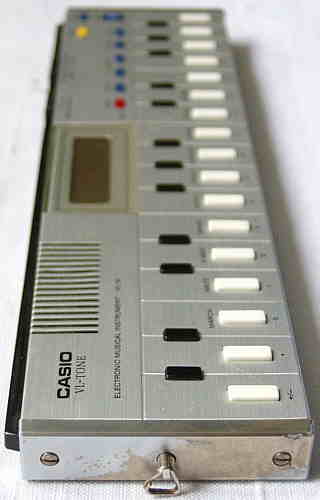 |
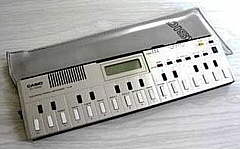 This is just an eBay photo; my VL-10 lacks the bag.
This is just an eBay photo; my VL-10 lacks the bag. |
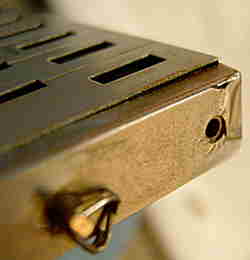 Also
the metal plating is rotten... Also
the metal plating is rotten... |
...and the battery cover is gone. |
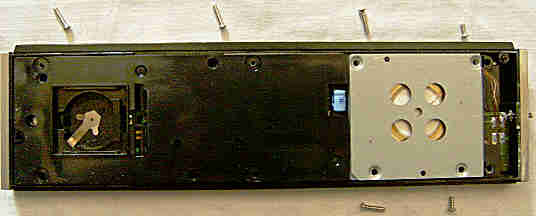
The screws have different lengths. |
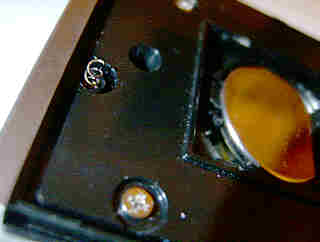
Don't loose the GND spring. |
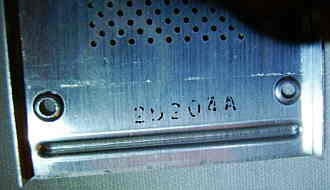 |
 |
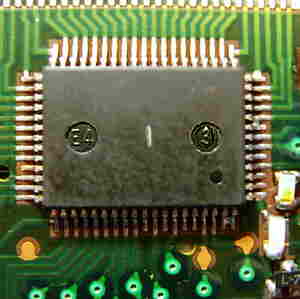 |
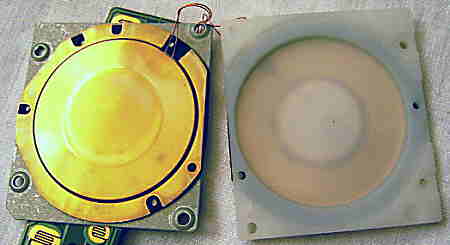
The speaker is a unique sandwich construction. |
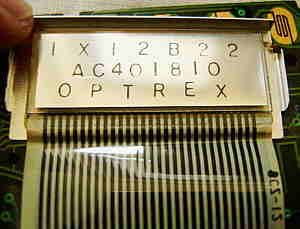 |
 |
The CPU has no type printed on (or is the label hidden on its solder side?) and the unused pins differ from the VL-1, but by a quick test the ADSR mode (blip sound) and octave switch functions seem to be still present as matrix eastereggs. Because the battery backed- up sequencer, calculator mode and LCD is all there, it is certainly easy to upgrade this thing with the ADSR synth feature; on the case rims is enough space to mount tiny slide switches for this. By the lack of analogue filters many timbres sound here identical those on a normal VL-1 would strongly differ, which is very noticeable during the demo melody. But otherwise the upgraded specimen certainly constitutes one of the world smallest self- contained synthesizers, and it is quite exciting to find out what happens when the different envelopes and timbres are squeezed out through its internal piezo yellcoin. Astonishing is that it holds the memory contents for at least an hour with battery removed.
The preset sounds "I" and "II" correspond to "piano" and "fantasy" on the normal VL-1. Sound "III" sounds like "fantasy" with shorter sustain, but I guess it is simply the "flute" preset sound that has a bit different timbre here by the lack of filter capacitors.
Casio also released an even smaller and normal shaped melody pocked calculator Casio VL-80, which also had a mini organ with sequencer built-in but lacked the sharp keys. But I don't know if this contained a different CPU.
 (photo from eBay, showing my specimen)
(photo from eBay, showing my specimen) |
This light blue plastic bomber was technically like PT-1, but is even missing the sequencer and tuning trimmer, thus only 4 sounds, the rhythms and the demo tune remained - what a shameful end for such a great programmable synthesizer hardware. Interesting is that my EP-10 has the roughest and most impulsive sounding percussion of these instruments - possibly Casio omitted some filter capacitors to save cost.
Another Muppets keyboard was the Casio
EP-20.
Other keyboards with the same CPU like the VL-1
were the PT-10 & PT-12 (resembling PT-1),
PT-22 (similar with 2 speakers), the CK-10 (2 speakers, built-in
radio) and CK-200 (ghettoblaster with radio and cassette deck).
Unfortunately they all lack the synthesizer.
circuit bending detailsI yet have not analyzed the Casio VL-1 keyboard matrix, but if you want to upgrade any of the crippled VL-1 variants with the synthesizer or other missing features, watch the wiring on this original VL-1 front panel PCB photo:(I have not analyzed the hardware further yet.) |
A 4 note polyphonic variant of the Casio VL-1 was the Casio
VL-5, which also featured a barcode reader to scan digital musical
scores from a book into the internal sequencer. The VL-5 is unfortunately
pretty rare and usually expensive now and has no synthesizer. In opposite
to this, the original VL-1 is fortunately still very easy to find at eBay
(max. 15€), thus everybody who wants to try out "the real thing" can
still get this wonderful piece of electronic music history. (The digeridoo
trick works only well with a real VL-1 or VL-5.)
| removal of these screws voids warranty... | ||
 |
||
|
|